Divided Families
Much as the nation was divided between the North and the South, Tennessee was divided between the Unionist East Tennessee and the Confederate Middle and West Tennessee.
But even this was not an exact dividing line. Throughout Tennessee, people living next to each other sometimes supported opposite sides. And even in families, some supported the South while others supported the North.
Old Glory’s William Driver
No family was more divided than William Driver’s of Nashville. Driver, a former Massachusetts sea captain, was the first person to call the American flag "Old Glory." It was a nickname he called an American flag presented to him to fly on his ship.
When Tennessee seceded from the Union, Driver hid Old Glory to keep it safe from Confederate sympathizers. Even though Driver supported the Union cause, two of his sons decided to join the Confederate army, one in the Nashville unit called the “Rock City Guards.”
In March 1862, Driver wrote “Two sons in the army of the South! My entire house estranged...and when I come home...no one to soothe me...”
When Union troops entered Nashville, Driver retrieved Old Glory from its hiding place. He gave it to Union soldiers who flew it from the top of the State Capitol. Driver’s happiness was short-lived. One of his sons, George, was wounded at the Battle of Perryville, Kentucky, in 1862 and died from his wounds.
Father against son
Thomas A.R. Nelson was a Unionist from East Tennessee who a member of Congress. After the war began, he was arrested by Confederates and sent to Richmond, Virginia, as a prisoner. Later paroled, he moved to Knoxville after it was taken by the Union army. Two of his sons joined the Confederate army while two served in the Union army.
When Nelson heard that one of his sons had been captured by the Union army and imprisoned, he pleaded with President Abraham Lincoln for his son's release. Lincoln wrote that the "Hon. Mr. Nelson of Tennessee is a man of rank and one whom I would like to have obliged." The son took the oath of Union allegiance and was released.
Brother against brother
William and Edward Cooper were brothers who lived in Tennessee. Each took a different side, even before the war began.
In a letter to another brother, Matthew, in 1856, William wrote, “We have so often...differed upon...politics, that it is not surprising that we should differ again now, when the Union seems in actual peril.” This difference does not have seemed to cause a rift between the brothers, because William continued, “How he can come to such a conclusion passes my comprehension, but that he is honest no one who knows him can doubt.”
There are examples of brothers who joined opposing armies and possibly were in the same battle. Five members of the 24th Tennessee Union regiment said they had brothers in the Confederate army.
One East Tennessee father, John F. Henry, who was pro-Union, tried to convince his daughter’s husband not to join the Confederate army. He attempted to make his son-in-law feel guilty about leaving his family. “The claims of wife and children would weigh in the balance with me much more than all the [politicians] in the world.” (June 7, 1861)
Husbands and wives
Another father apparently tried to persuade his daughter to leave her Unionist husband. Sarah Kennedy wrote her husband on Dec. 19, 1862, that an acquaintance was in town to take his family north. “I suppose he is ashamed to show his face...I think his wife has refused to go because her father is so much opposed to it.”
Louisa Brown Pearl’s family voluntarily separated during the war. Her husband, an ardent Unionist, took their daughters north to Detroit, Michigan, in August, 1861. Louisa decided to stay and protect their home as well as watch over their son who had enlisted in C Company, First Tennessee Infantry, C.S.A. At this time she started a diary. Apparently, communications between family members was sporadic.
January 21, 1862: “This morning received a letter from my husband. I trembled with excitement & laughed & wept over it like a child. I am pained to learn that they have not heard from me since Oct. Have written directly back...and hope that ...they get one letter at least from me.”
With Tennessee under Union control for most of the four years of the war, it is not surprising that romance and marriages occurred between Confederate women and Union soldiers. Gates Thruston of the 1st Ohio Infantry wrote his mother in March 1865, that the women of Nashville were through “playing the part of nuns and being true to their southern [boys] and allegiance.” He said they “smile upon the Federals...and are always ready for a flirtation.”
Months after he wrote this letter, Thruston married one of the southern women, Ida Hamilton. Written documents report that after their marriage, his wife hung portraits of Confederate Generals Robert E. Lee and Stonewall Jackson in their reception room. Perhaps his report of the women giving up their Confederate allegiance was not exactly accurate.
Picture Credits:
- Ambrotype, photograph, of three members of the Rock City Guards, a Confederate unit from Nashville. Tennessee State Museum Collection, 2006.212.1
- William Driver, carte-de-visite, a type of photograph. Below the photograph is a pen inscription "Old Glory." Tennessee State Museum Collection, 89.103.1
- Thomas A.R. Nelson family, probably 1858. The mother died in 1850, but since the children are shown at older ages, it is assumed the painting was done after her death. Two of the sons served in the Union army while two other sons joined the Confederates. Tennessee State Museum Collection, 83.112
- “Captain William Driver” by unknown artist. This portrait was given to the state by his daughter, Mrs. Mary Driver Roland, of California, in 1927, shortly before her death. Tennessee State Museum Collection, 76.33
- A photograph of the house that had belonged to William Driver during the Civil War. The house was located on Fifth Avenue near Peabody Street in Nashville. This photograph appeared in Harper's Weekly in December 1909. Tennessee State Museum Collection
- A photograph of Gates Phillips Thruston around 1875. Thruston served with the 1st Ohio Infantry and after the war married a Nashville woman and settled here. Tennessee State Library and Archives
Civil War and Reconstruction >> Civil War >> A Divided State >> Divided Families
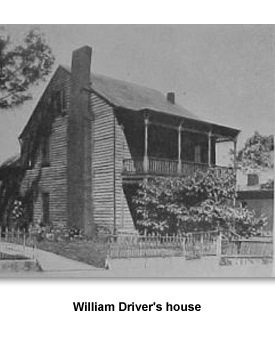
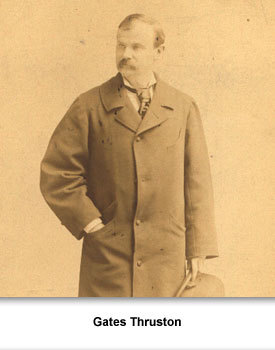
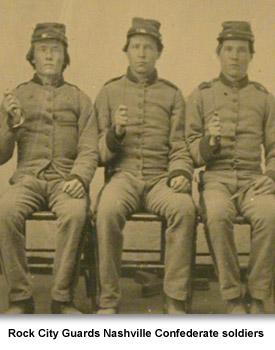
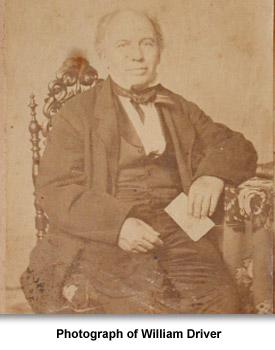
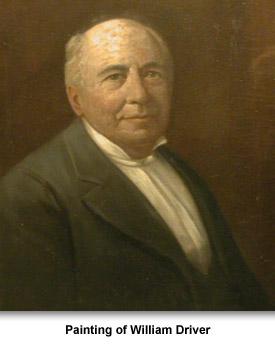
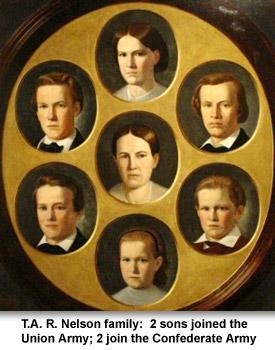
 Sponsored by: National Endowment for the Humanities
Sponsored by: National Endowment for the Humanities